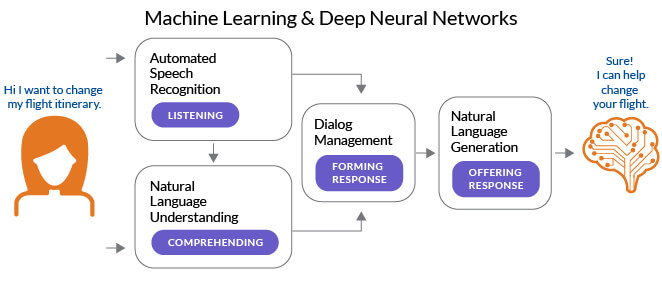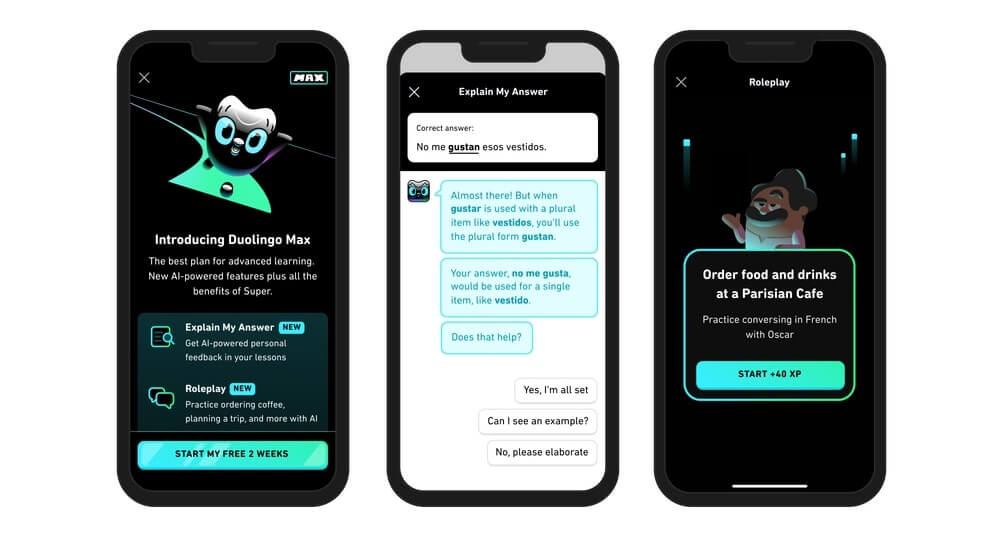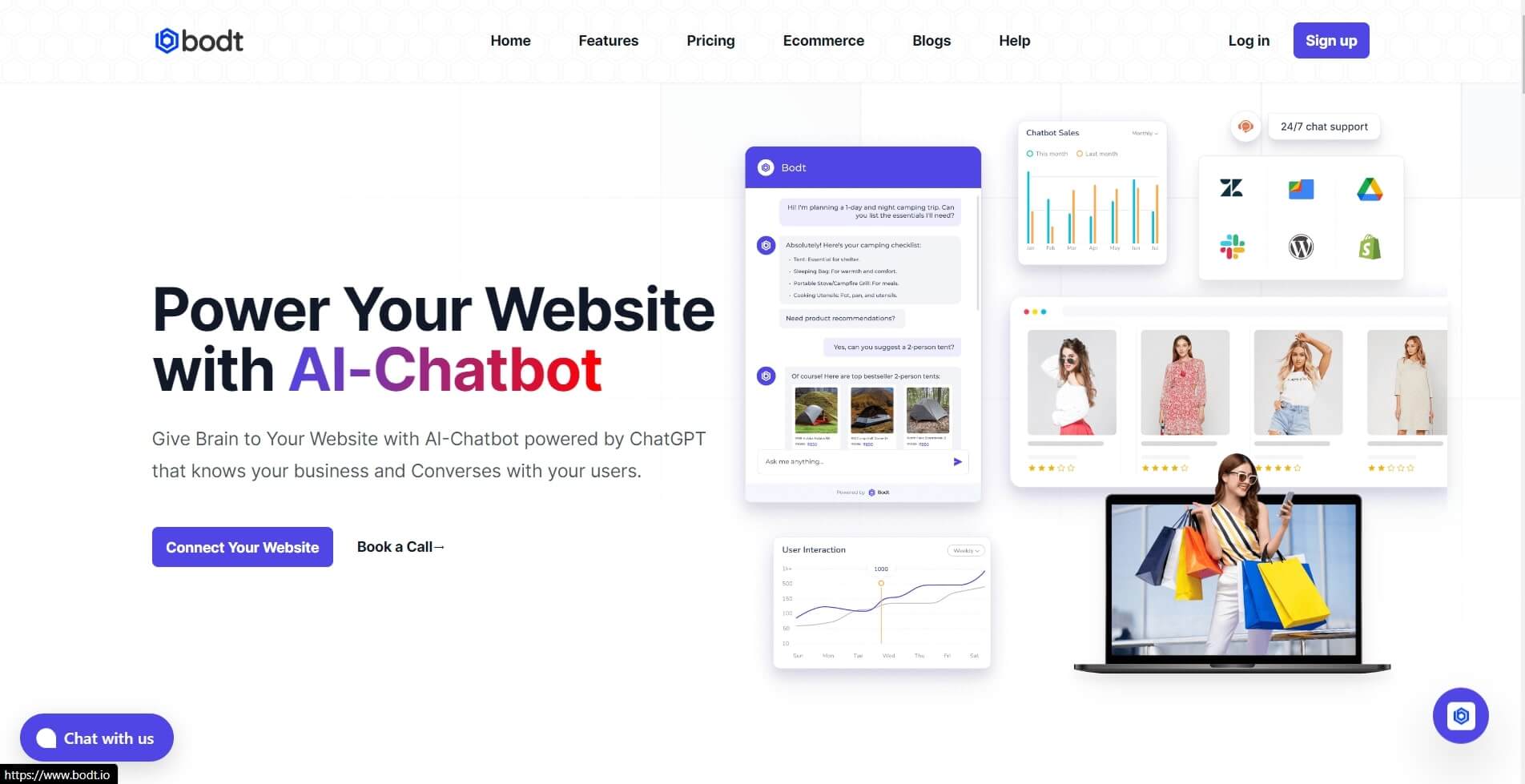
Conversational artificial intelligence is rapidly becoming a crucial part of many businesses today. It helps you automate your customer communication with its robust natural language processing and machine learning capabilities. It can interact with your customers by automatically understanding their intent and providing accurate responses to their queries.
Although the adoption of conversational AI is still in its infancy stages, it is expected to grow in the coming years. The global conversational market is expected to grow to $14 billion) by 2025.
In this post, we will learn more about conversational AI, how it works, and the benefits it offers. We will also explore some examples of conversational AI and suggest a few conversational AI tools you can consider investing in this year.
What Is Conversational AI?
Conversational artificial intelligence or conversational AI is an AI technology that enables software to understand, interpret, and respond to text-based or voice-based human conversations. It uses natural language processing (NLP) and machine learning (ML) algorithms to build large language models to process and understand human language and mimic human interactions.
Due to its ability to facilitate interactive conversations, conversational AI is leveraged by brands to deliver exceptional experiences to customers via various channels like websites, mobile apps, messaging apps, and others.
Components of Conversational AI
 Natural Language Processing
Natural Language Processing |
 Machine Learning
Machine Learning |
|
| Conversational AI | ||
 Computer Vision
Computer Vision |
 Speech Recognition
Speech Recognition |
|
As we said earlier, conversational AI uses advanced technologies like NLP and ML to understand human inputs. These technologies are the most important components of conversational AI, in addition to a few more.
- Natural Language Processing Conversational AI uses NLP to understand human language and produce relevant responses. It breaks down the query to analyze the structure of sentences, the meaning of the words, and more to generate outputs that are well-understood by humans.
- Machine Learning Conversational AI leverages ML to identify the patterns or trends in massive data sets, learn from them, and make predictions for the future. This educates your AI system to identify the inputs and respond to the queries with greater accuracy.
- Speech Recognition As the name suggests, speech recognition enables conversational AI systems to understand human speech. This includes understanding the different sounds in a spoken sentence, its tone, grammar, and so on. It also tries to interpret the emotions of individuals through their voices and understand the context of the conversation.
- Computer Vision Conversational AI leverages computer vision to analyze and interpret digital images. It uses this technology to identify the different objects in the image and determine the relationship between the different objects. It can also identify the emotions of the individuals in the images as well as their location.
How Conversational AI Works?
Conversational AI interacts with humans following the below-mentioned steps.
- Step 1 - Receive input from the human
The conversational AI tool receives input from humans in a written text format or spoken words. It recognizes the input and converts it into machine-readable format.
- Step 2 - Understand the input It then tries to grasp what the input means. To do so, it leverages the natural language understanding (NLU) part of the NLP algorithms.
- Step 3 - Determine the response Based on the input query, the conversational AI tool understands the intent of the query and determines the best possible response. It then utilizes the natural language generation (NLG) part of the NLP algorithm to convert the response into a human-readable format.
- Step 4 - Delivers the response Once the response is generated, the conversational AI tool shares the response as output in the format that it was originally received in.

Source - Design a similar image
What Is an Example of Conversational AI?
As the conversational AI industry continues to evolve, a number of conversational AI tools are introduced in the market. Chatbot is the best example of conversational AI. Other include virtual agents, virtual personal assistants, voice-activated bots, FAQ bots, and so on.
Although conversational AI and chatbots may appear to be quite similar, there are significant differences between the two.
Conversational AI vs Chatbot
Traditional chatbots rely on pre-defined rules or workflows and fixed responses to share responses to customer queries. On the other hand, conversational AI leverages advanced algorithms to understand the customer's intent behind the query before providing them with relevant answers.
Chatbots are often utilized for carrying out basic tasks like sharing shipping information, providing answers to commonly asked questions, and so on. While conversational AI is most suitable for handling complex customer queries related to sales and support.
Chatbots are often rule-based which usually restricts their functionality and cannot be leveraged for anything other than predefined tasks. Conversational AI can handle any type of use case while providing accurate responses in every situation.
Why Does Your Business Need Conversational AI in 2024?
Here are the top reasons why businesses must use conversational AI in 2024.
Automates Customer Interactions
Conversational AI can share quick answers to your customer queries without any human agent intervention. Due to its NLP capabilities, it can automatically understand the customers' queries and offer accurate responses in no time. It can also analyze customer sentiments and provide more personal experiences to the customers.
Saves Time
Conversational AI is designed to handle multiple customer queries at a time. So, if there is an influx of customer queries at any point in time, you can handle them with a conversational AI tool. Conversational AI can take up the simpler queries while passing on the complex ones to your team. It ensures that every customer's questions are addressed without requiring you to overburden your team.
Available 24*7
Conversational AI makes it possible for you to be available for your customers no matter which location or timezone they belong to. If a customer needs help outside of your regular business hours, a conversational AI chatbot can attend to their issues. This enhances the overall customer experience and strengthens brand loyalty.
Reduces Customer Service Costs
As conversational AI can automate repetitive customer inquiries, you do not have to rely on human agents all the time. This drastically reduces your staffing requirements which generally take up a chunk of your budget. Further, the conversational AI can handle any volume of queries within a shorter time thereby reducing operational costs and resulting in significant savings.
Offers Multilingual Support
Conversational AI eliminates language barriers as most conversational AI tools come with built-in functionality to detect, interpret, and generate any language proficiently. This helps you to connect with customers from various geographical locations and grow your business beyond your country's borders.
Boost Customer Engagement
Conversational AI has numerous ways to engage your customers. For example, AI-powered chatbots can offer shipping information about orders to customers. Similarly, virtual assistants can offer personalized product recommendations. It ensures that your services and products meet your customers' needs and contribute to growing your revenue.
What Are Conversational AI Tools?
Conversational AI tools are specialized software tools that leverage conversational AI technology to engage with your customers with human-like conversations. These tools are used to simplify communication with customers across various industries. Some of these industries are customer service, customer support, sales, and marketing.
From tried-and-tested chatbots to voice-activated assistants, conversational AI tools help you build amazing relationships with your customers while maintaining your brand voice. It helps you level up your customer service game and boost team productivity.
That being said, let us explore how leading brands are leveraging conversational AI to boost their customer experiences.
5 Conversational AI Use Cases, Examples, and Applications
1. Apple
Everyone knows about Siri, the virtual assistant on iPhones. Siri is a conversational AI that Apple has deployed to help its customers. Siri is equipped to identify voice commands of customers using NLP, ML, and other AI technologies.
Siri helps its users with a variety of tasks like getting directions, scheduling appointments, setting reminders, finding information on the web, dialing phone calls, responding to text messages, and much more. It is available on all Apple devices, such as iPhones, iPads, Apple Watches, and more.

2. Amazon
Amazon's Alexa is the next example of conversational AI. It is another voice-controlled virtual assistant that can perform a wide range of tasks for you. It is integrated with Amazon's Echo devices and other smart appliances to provide voice-activated services to customers.
Besides the usual tasks for simplifying your life, Alexa can help you with your shopping on Amazon. It can build your shopping lists, place orders for your desired product on Amazon, share highly personalized product recommendations, get notified about upcoming deals on Amazon, and so much more. Alexa has helped Amazon deliver exceptional shopping experiences to customers.

3. Duolingo
Duolingo, a popular language learning app utilizes conversational AI to gamify the language learning process. It employs AI-powered chatbots to simulate conversations with the customers. This includes both text chatbots as well as voice-enabled chatbots.
The goal behind gamifying the entire process and making it interactive is to encourage users to practice their language skills in the most realistic manner. It offers various speaking exercises, self-paced exercises, interactive tests, and more to support the learning process.
Duolingo has launched its conversational AI feature, Duolingo Max, that offers extensive conversation practice and in-depth explanations of answers to users. The company aims to recreate the experience of a human teacher with this new AI feature.

4. Domino’s Pizza
Domino's Pizza has integrated a conversational AI chatbot, Dom that assists you with ordering pizzas on their website and mobile app. This virtual customer assistant can help you locate Domino's stores near you, track your order, connect you with the store you placed your order with, and respond to any other queries.
Domino's has also deployed its intuitive chatbot on various messaging apps. In fact, customers could simply send a pizza emoji to the chatbot and the chatbot would prompt them with further instructions.

5. Sephora
Sephora, a leading beauty brand offers a chatbot that is powered by conversational AI to boost shopping experiences for its customers. It offers a complete virtual makeover solution that allows customers to try on their favorite products virtually, without visiting the physical store. Customers can try out various products including lipsticks, eyeshadows, foundations, and even false lashes to understand how those products look on them.
The virtual artists also offer guided tutorials on face contouring, lip lining, and other latest beauty trends in addition to product recommendations.

Top Conversational AI Companies
If you are looking to invest in top conversational AI platforms, here are two of our best recommendations for you.
1. Bodt - For Text Chats

Bodt is a rapidly growing conversational AI tool that simplifies customer communication for major eCommerce brands across the world. Powered by GPT-4 and conversational AI technology, Bodt designs seamless human-like interactions to engage your customers and enhance customer satisfaction. It is a no-code conversational AI chatbot platform that lets you create AI-powered chatbots without writing a single line of code.
Key Features -
- Build intuitive chatbots in just three steps using Bodt's no-code chatbot builder.
- Generate embed code in a few seconds to integrate your chatbot with your website.
- Customize the look and feel of the chatbot to match your brand aesthetics.
- Generates accurate responses in various languages due to its multilingual support capabilities.
- Supports numerous integrations like Shopify, WordPress, and more.
2. SoundHound - For Voice Chats

SoundHound AI is a voice AI platform that helps businesses deliver exceptional conversational experiences to customers via voice-enabled chatbots. The company built its proprietary technologies namely Speech-to-Meaning and Deep Meaning Understanding to enable customers to ask their queries to the chatbot by speaking naturally - just how we interact with one another. It supports real-time translation of spoken language thereby eliminating the need for recording the speech and then interpreting its meaning.
SoundHound is leveraged by multiple industries for streamlining customer experiences. This includes restaurants, hospitality, automotive, smart devices, and much more.
It offers two additional tools -
- SoundHound Music App - To discover and play your favorite songs by singing them or merely humming.
- Hound Voice Assistant - To receive accurate responses to all your queries on topics like weather, travel, books, and so on.
Key Features -
- Create custom voice-enabled experiences by turning spoken commands into actionable responses.
- Supports diverse languages and their dialects with complete accuracy.
- Understands voice commands without any lag or misunderstanding.
- Monitor and track usage analytics to optimize customer experiences.
Conclusion
Conversational AI is becoming an indispensable part of the customer service industry. Conversational AI software solutions are simplifying your business by taking over repetitive customer service tasks and freeing up your human agent's time for complex work.
With conversational AI tools like Bodt, you can implement conversational chatbots within a few minutes and boost your customer interactions. Get in touch with our team to explore how our conversational AI solution can transform your customer service.
